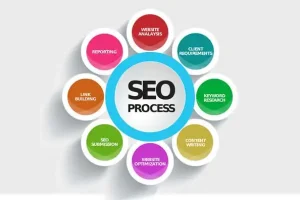
Product Page SEO: A Complete Guide
In the competitive world of e-commerce, having a well-optimized product page is essential for attracting organic traffic and driving sales. Product page SEO involves optimizing various elements of your product pages to ensure they rank well on search engine results pages (SERPs) and attract potential customers. In this comprehensive guide, we’ll delve into the key strategies and techniques to optimize your product pages for maximum visibility and conversions.
Section 1: Understanding Product Page SEO
1.1 What is Product Page SEO?
Product page SEO refers to the process of optimizing individual product pages on your e-commerce website to improve their visibility and ranking on search engines. By optimizing product titles, descriptions, images, and other elements, you can increase the likelihood of your products appearing in relevant search queries.
1.2 Why Product Page SEO Matters
Optimizing product pages for SEO is crucial for several reasons:
Increased Visibility: Higher rankings on SERPs lead to increased visibility and exposure to potential customers.
Higher Conversions: Well-optimized product pages are more likely to attract qualified traffic, resulting in higher conversion rates.
Competitive Advantage: Outranking competitors on search engines can give you a competitive edge in the e-commerce market.
Section 2: Key Elements of Product Page SEO
2.1 Keyword Research:
Start by conducting keyword research to identify relevant keywords and phrases that potential customers are using to search for products similar to yours. Focus on long-tail keywords that have lower competition but higher intent.
2.2 Optimizing Product Titles:
Craft descriptive and keyword-rich product titles that accurately reflect the product and its features. Include primary keywords towards the beginning of the title and keep it concise yet informative.
2.3 Compelling Product Descriptions:
Write unique and engaging product descriptions that highlight the features, benefits, and unique selling points of the product. Incorporate relevant keywords naturally throughout the description while ensuring readability and clarity.
2.4 High-Quality Images and Alt Text:
Use high-quality images that showcase the product from different angles and perspectives. Optimize image filenames and alt text with descriptive keywords to improve accessibility and help search engines understand the content of the images.
2.5 Structured Data Markup:
Implement structured data markup, such as product schema markup, to provide search engines with additional information about your products. This can enhance the visibility of your products on SERPs and result in rich snippets.
2.6 User Reviews and Ratings:
Encourage customers to leave reviews and ratings for your products. Positive reviews not only build trust with potential buyers but also contribute to increased visibility and rankings on search engines.
Section 3: Technical Optimization for Product Pages
3.1 Site Speed Optimization:
Optimize your website’s loading speed to ensure fast and seamless user experience. Compress images, minify CSS and JavaScript files, and utilize browser caching to improve page speed, which is a crucial ranking factor for search engines.
3.2 Mobile-Friendliness:
Ensure that your product pages are optimized for mobile devices, as a significant portion of e-commerce traffic comes from mobile users. Use responsive design principles to provide a consistent and user-friendly experience across different devices.
3.3 Internal Linking:
Implement internal linking strategies to connect related product pages and improve navigation within your website. This not only enhances user experience but also distributes link equity and helps search engines discover and index your product pages more effectively.
Section 4: Measuring and Monitoring Product Page SEO Performance
4.1 Google Analytics:
Track key metrics such as organic traffic, conversion rates, and bounce rates using Google Analytics. Analyze user behavior on your product pages to identify areas for improvement and refine your SEO strategy accordingly.
4.2 Search Console:
Monitor your product pages’ performance on Google Search Console. Identify keyword rankings, click-through rates, and indexing issues, and take necessary actions to optimize your product pages for better visibility and performance.
Section 5: Creating Compelling Product Page Content
5.1 Utilize Unique Selling Propositions (USPs):
Highlight the unique features and benefits of your products to differentiate them from competitors. Clearly communicate what sets your products apart and why customers should choose them over alternatives.
5.2 Address Customer Pain Points:
Identify common pain points or challenges that your target audience faces, and demonstrate how your products can solve these problems. Use persuasive language to connect with potential customers on an emotional level and address their needs effectively.
5.3 Include Calls-to-Action (CTAs):
Incorporate clear and compelling calls-to-action (CTAs) throughout your product pages to prompt users to take desired actions, such as making a purchase or requesting more information. Use action-oriented language and place CTAs strategically to encourage conversions.
Section 6: Optimizing Product Page URLs and Meta Tags
6.1 SEO-Friendly URLs:
Create descriptive and concise URLs for your product pages that contain relevant keywords and accurately reflect the content of the page. Avoid using generic or cryptic URLs, and use hyphens to separate words for readability.
6.2 Meta Titles and Descriptions:
Write compelling meta titles and descriptions that accurately summarize the content of your product pages and entice users to click through from search engine results. Include relevant keywords naturally within meta tags while maintaining readability and relevance.
Section 7: Leveraging User-Generated Content (UGC)
7.1 Customer Reviews and Testimonials:
Feature authentic customer reviews and testimonials on your product pages to provide social proof and build trust with potential buyers. Showcase positive feedback and ratings prominently, and encourage satisfied customers to share their experiences.
7.2 User-Generated Images and Videos:
Encourage customers to submit photos and videos of your products in use, and showcase these user-generated images and videos on your product pages. This not only adds authenticity but also provides valuable visual content that can influence purchasing decisions.
Section 8: A/B Testing and Optimization
8.1 Conduct A/B Tests:
Experiment with different elements of your product pages, such as headlines, images, CTAs, and product descriptions, through A/B testing. Compare variations to determine which elements resonate best with your audience and lead to higher conversion rates.
8.2 Continuous Optimization:
Regularly monitor and analyze the performance of your product pages, and make iterative improvements based on data-driven insights. Test different strategies, measure results, and refine your approach to product page optimization over time for continuous growth and success.
Section 9: Local SEO for Product Pages
9.1 Local Keyword Targeting:
If your business serves specific geographic regions, optimize your product pages for local search by targeting relevant local keywords. Include location-specific terms in your product titles, descriptions, and meta tags to attract local customers.
9.2 Google My Business Optimization:
Claim and optimize your Google My Business listing to improve your visibility in local search results. Ensure that your business information, including address, phone number, and hours of operation, is accurate and up-to-date to enhance local SEO for your product pages.
Section 10: Monitoring Competitors and Industry Trends
10.1 Competitor Analysis:
Regularly monitor your competitors’ product pages to identify strategies, keywords, and tactics that are driving their success. Analyze their content, backlink profiles, and user engagement to gain insights and refine your own product page SEO strategy accordingly.
10.2 Stay Updated on Industry Trends:
Keep abreast of industry trends, changes in consumer behavior, and emerging technologies that may impact product page SEO. Stay informed through industry publications, forums, and conferences to stay ahead of the curve and adapt your strategy proactively.
Section 11: Building Quality Backlinks
11.1 Guest Blogging and Outreach:
Identify reputable websites and blogs in your industry and contribute guest posts with backlinks to your product pages. Focus on providing valuable content that aligns with the interests of the target audience, and cultivate relationships with influencers and industry experts for guest blogging opportunities.
11.2 Partner with Influencers:
Collaborate with influencers and bloggers in your niche to promote your products and earn backlinks to your product pages. Leverage their reach and influence to amplify your brand’s visibility and attract high-quality backlinks from authoritative sources.
Section 12: User Experience (UX) Optimization
12.1 Clear Navigation and Site Structure:
Ensure that your website has a clear and intuitive navigation structure that makes it easy for users to find and navigate to your product pages. Optimize your site’s hierarchy, breadcrumbs, and internal linking to enhance the user experience and facilitate search engine crawling and indexing.
12.2 Mobile Optimization:
Optimize your product pages for mobile devices to accommodate the growing number of mobile users. Use responsive design principles, optimize page speed, and prioritize mobile-friendly features to ensure a seamless and user-friendly experience across all devices.
Conclusion:
Optimizing product pages for SEO is a dynamic and multifaceted process that requires ongoing effort, attention to detail, and adaptation to changing trends and algorithms. By implementing the strategies outlined in this guide, you can create product pages that not only rank well on search engines but also engage users, drive conversions, and outperform competitors in the ever-evolving e-commerce landscape. Remember to focus on providing valuable content, optimizing technical elements, and fostering positive user experiences to maximize the impact of your product page SEO efforts and achieve long-term success for your business.
Tag:A/B Testing, Alt Text, backlink, Competitor Analysis, Complete Guide, Data, Data Markup, data-driven insights, e-commerce traffic, geographic regions, Google Analytics, Google My Business, High-Quality Images, influencers, Internal Linking, Keywords, optimization, organic traffic, positive review, Product Page SEO, Product Pages, SEO, SEO Performance, SEO strategy, SERP, Site Speed Optimization, Structured Data Markup, trust





